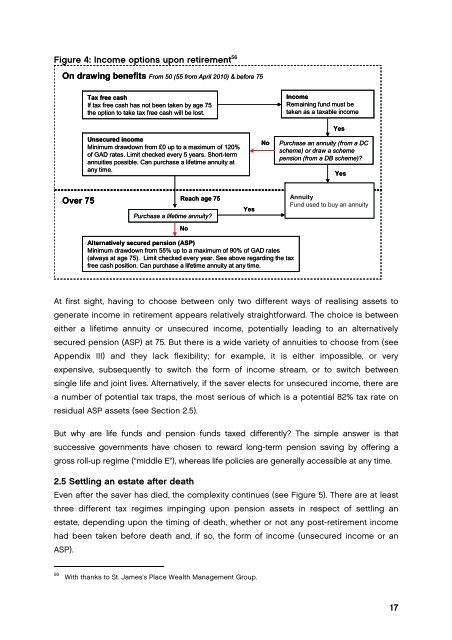Simplification is the key - Centre for Policy Studies
Simplification is the key - Centre for Policy Studies
Simplification is the key - Centre for Policy Studies
You also want an ePaper? Increase the reach of your titles
YUMPU automatically turns print PDFs into web optimized ePapers that Google loves.
Figure 4: Income options upon retirement 56<br />
On drawing benefits From 50 (55 from April 2010) & be<strong>for</strong>e 75<br />
Tax free cash<br />
If tax free cash has not been taken by age 75<br />
<strong>the</strong> option to take tax free cash will be lost.<br />
Unsecured income<br />
Minimum drawdown from £0 up to a maximum of 120%<br />
of GAD rates. Limit checked every 5 years. Short-term<br />
annuities possible. Can purchase a lifetime annuity at<br />
any time.<br />
No<br />
Income<br />
Remaining fund must be<br />
taken as a taxable income<br />
Yes<br />
Purchase an annuity (from a DC<br />
scheme) or draw a scheme<br />
pension (from a DB scheme)?<br />
Yes<br />
Over 75<br />
Reach age 75<br />
Purchase a lifetime annuity?<br />
Yes<br />
Annuity<br />
Fund used to buy an annuity<br />
No<br />
Alternatively secured pension (ASP)<br />
Minimum drawdown from 55% up to a maximum of 90% of GAD rates<br />
(always at age 75). Limit checked every year. See above regarding <strong>the</strong> tax<br />
free cash position. Can purchase a lifetime annuity at any time.<br />
At first sight, having to choose between only two different ways of real<strong>is</strong>ing assets to<br />
generate income in retirement appears relatively straight<strong>for</strong>ward. The choice <strong>is</strong> between<br />
ei<strong>the</strong>r a lifetime annuity or unsecured income, potentially leading to an alternatively<br />
secured pension (ASP) at 75. But <strong>the</strong>re <strong>is</strong> a wide variety of annuities to choose from (see<br />
Appendix III) and <strong>the</strong>y lack flexibility; <strong>for</strong> example, it <strong>is</strong> ei<strong>the</strong>r impossible, or very<br />
expensive, subsequently to switch <strong>the</strong> <strong>for</strong>m of income stream, or to switch between<br />
single life and joint lives. Alternatively, if <strong>the</strong> saver elects <strong>for</strong> unsecured income, <strong>the</strong>re are<br />
a number of potential tax traps, <strong>the</strong> most serious of which <strong>is</strong> a potential 82% tax rate on<br />
residual ASP assets (see Section 2.5).<br />
But why are life funds and pension funds taxed differently? The simple answer <strong>is</strong> that<br />
successive governments have chosen to reward long-term pension saving by offering a<br />
gross roll-up regime (“middle E”), whereas life policies are generally accessible at any time.<br />
2.5 Settling an estate after death<br />
Even after <strong>the</strong> saver has died, <strong>the</strong> complexity continues (see Figure 5). There are at least<br />
three different tax regimes impinging upon pension assets in respect of settling an<br />
estate, depending upon <strong>the</strong> timing of death, whe<strong>the</strong>r or not any post-retirement income<br />
had been taken be<strong>for</strong>e death and, if so, <strong>the</strong> <strong>for</strong>m of income (unsecured income or an<br />
ASP).<br />
56<br />
With thanks to St. James’s Place Wealth Management Group.<br />
17

















